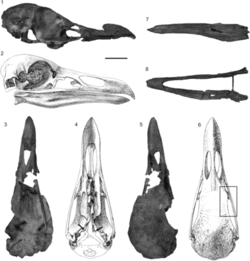Neocathartes
| Neocathartes Temporal range: Late Eocene | |
|---|---|
 | |
| Bathornis grallator ('Neocathartes') skull. | |
| Fossil | |
| Scientific classification | |
| Kingdom: | Animalia |
| Phylum: | Chordata |
| Class: | Aves |
| Order: | Cariamae |
| Family: | Bathornithidae |
| Genus: | Neocathartes Wetmore, 1950 |
| Species: | N. grallator (Wetmore, 1944) |
| Binomial name | |
| Neocathartes grallator | |
| Synonyms | |
|
Genus-level: Species-level:
| |
Neocathartes is an extinct genus of cariamid bird. It contains a single named species, Neocathartes grallator ("walking new turkey vulture"), known from some fossil bones found in Late Eocene (c. 37-34 mya) Washakie Formation deposits of Wyoming. Similar bones have been recovered from the Early Eocene Willwood Formation. The genus originally set up by Wetmore, Eocathartes, was already in use for an unrelated fossil bird from Germany, so a new genus had to be established for the Wyoming fossil.[2]
Initially mistaken for a walking New World vulture, Neocathartes is now classified as a bathornithid, a family of cariamaeans. Neocathartes was a slender bird, around the size of a turkey vulture. It was a flightless bird, [3][4] much like other bathornithids, and most likely a terrestrial predator in the same vein as the related phorusrhacid birds.
The misattribution of Neocathartes was resolved by Storrs Olson.[5] Usually a serious, no-nonsense scientist, he could not help noting,
The reconstruction published with the original description of Neocathartes has often been reprinted and has now made the "terrestrial vulture" an integral part of the lore of avian paleontology. Well, forget it.
Neocathartes is just our old friend Bathornis in another guise.
He considered the genus Neocathartes a junior synonym of Bathornis. This was usually rejected by subsequent studies, but more recently Gerald Mayr et Jorge Noriega 2015 have recovered Neocathartes within Bathornis.[6]
References
- ↑ Wetmore, Alexander (1944). "A new terrestrial vulture from the Upper Eocene deposits of Wyoming". Annals of the Carnegie Museum. 30: 57–69.
- ↑ Wetmore, Alexander (1950). "A Correction in the Generic Name for Eocathartes grallator" (PDF). Auk. 67 (2): 235. doi:10.2307/4081223.
- ↑ Cracraft, J. (1968). "A review of the Bathornithidae (Aves, Gruiformes), with remarks on the relationships of the suborder Cariamae". American Museum Novitates. 2326: 1–46. Retrieved 2016-04-28.
- ↑ Gerald Mayr (2016). "Osteology and phylogenetic affinities of the middle Eocene North American Bathornis grallator—one of the best represented, albeit least known Paleogene cariamiform birds (seriemas and allies)". Journal of Paleontology 90 (2): 357–374. doi:10.1017/jpa.2016.45.
- ↑ Olson, Storrs L. (1985): Section X.A.I.b. The Tangle of the Bathornithidae. In: Farner, D.; King, J. & Parkes, K. (eds.): Avian Biology 8: 146–150. Academic Press, New York.
- ↑ Mayr, G., & Noriega, J. I. A well-preserved partial skeleton of the poorly known early Miocene seriema Noriegavis santacrucensis (Aves, Cariamidae).
External links
- An outdated reconstruction of Neocathartes as a walking New World vulture
- A much more accurate reconstruction (though details are still conjectural of course)